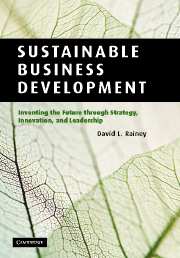Book contents
- Frontmatter
- Contents
- List of figures
- List of tables
- List of boxes
- List of abbreviations
- Acknowledgments
- Introduction
- Part I Enterprise thinking, the driving forces of change, and leadership
- Part II Innovation management, life cycle considerations, and insights
- 7 Sustainable technology management and development
- 8 Crafting and implementing sustainable business development programs
- 9 Life cycle thinking and framework
- 10 Formulation of life cycle assessment: initiation and inventory assessment
- 11 Implementation of life cycle assessment: impact and improvement assessments
- 12 Inventing the future through enterprise thinking and sustainable business development
- Glossary
- Select bibliography
- Index
- References
7 - Sustainable technology management and development
from Part II - Innovation management, life cycle considerations, and insights
Published online by Cambridge University Press: 04 December 2009
- Frontmatter
- Contents
- List of figures
- List of tables
- List of boxes
- List of abbreviations
- Acknowledgments
- Introduction
- Part I Enterprise thinking, the driving forces of change, and leadership
- Part II Innovation management, life cycle considerations, and insights
- 7 Sustainable technology management and development
- 8 Crafting and implementing sustainable business development programs
- 9 Life cycle thinking and framework
- 10 Formulation of life cycle assessment: initiation and inventory assessment
- 11 Implementation of life cycle assessment: impact and improvement assessments
- 12 Inventing the future through enterprise thinking and sustainable business development
- Glossary
- Select bibliography
- Index
- References
Summary
Introduction
Strategic technology management, technological innovation, and product development play vital roles in developing solutions to social, economic, environmental and market-related problems and in creating new opportunities. They provide the means and mechanisms to fundamentally change the enterprise in its quest for achieving excellence.
“Technology” is a complex term that includes art, science, engineering, devices, methods, and know-how that are applied in a beneficial manner. It usually takes the form of products and processes (hardware and software) that can be used to create solutions. At the beginning of the twentieth century, technology was typically viewed as the application of science, engineering, and art for developing useful apparatuses with complementary and supporting devices. The automobile is a good example. Automobile technology provided the means to create a self-propelled vehicle based on the internal combustion engine technology that converted chemical fuels into mechanical propulsion. However, the automobile is actually the fusion of many technologies into a useful end-product. The related technical devices used in the automobile met functional requirements: for instance, mechanical brakes, though unrelated to the primary function of vehicular motion, were critical for stopping the automobile.
In the twenty-first century, our view of technology has expanded beyond what is embodied within the products and processes to include the theories, knowledge, concepts, and constructs for creating beneficial outcomes. The Internet is the prime example.
Information
- Type
- Chapter
- Information
- Sustainable Business DevelopmentInventing the Future Through Strategy, Innovation, and Leadership, pp. 385 - 443Publisher: Cambridge University PressPrint publication year: 2006
